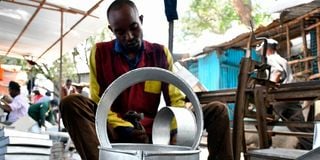Premium
Hard times beckon as economy is battered from several fronts

A jua kali tradesman at work at his shop on Landhies Road in Nairobi in May last year.
Storm clouds are fast gathering over Kenyans as drought, high cost of living, taxation and joblessness persist amid grand promises by the government.
Households are reeling from the strain of heightened inflation while businesses are struggling to find dollars to service their import requirements, including raw materials, at a time when more than five million Kenyans are at risk of starvation.
But amid this bleak outlook, top government officials, including President William Ruto and his deputy Rigathi Gachagua, have continued with an avalanche of promises, including cheaper cooking gas cylinders and affordable houses.
The situation could get worse before it gets better if the masses are to believe the mid-January assessment by Treasury Cabinet Secretary Njuguna Ndung’u.
“From all the things we have analysed, 2023 is not looking good; there are clear signals that it is going to be a tough year and that the global economy is one example in terms of where we are going,” he said.
Kenya’s public debt hit Sh9.145 trillion in December against the allowed limit of Sh10 trillion, leaving President Ruto’s administration with little room to borrow.
The shilling is officially exchanging at an all-time low of about 127 units to the dollar—translating to over 24 per cent depreciation since March 2020— but many banks and foreign exchange bureaus are quoting as high as 137 as the dollars become scarce.
Foreign currency reserves—the foreign currency-denominated money available to pay for imports—has fallen below the desired four-month cover and closed last Thursday at $6.605 billion (Sh844 billion) or an equivalent of 3.69 months import cover.
Foreign borrowing
The government is now counting on foreign borrowing and diaspora remittances to shore up the forex reserves, even as the country is due to fork out more than $2 billion (Sh256 billion) to investors in a bullet payment to retire the 10-year sovereign bond that was issued in 2014.
Salaries, allowances and loan repayments have left the government with little room to slam the brakes on borrowing or respond to the shocks facing households such as inflation. President Ruto’s attempt to cut Sh300 billion from the 2022/2023 budget only found space to save about Sh14 billion.
For Kenyan households, the cost of buying food and cooking it, renting a house and illuminating it or buying books and taking children to school or even enjoying an orange fruit, is on a rise.
Inflation—the rate of increase in prices over a given period— has stayed above the government’s desired range of between 2.5 per cent and 7.5 percent for the past nine months, piling pressure on households.
A kilo of cabbage was averaging Sh59.86 in February, being 20.2 per cent higher than it was in February last year while the same quantity of sukuma wiki is up 11.2 per cent to Sh66.86.
The price of a litre of un-processed cow milk has jumped 19.5 per cent to Sh72.71 as two kilogrammes of wheat flour rose 29.4 per cent to Sh187.51. Refilling a 13-kilogramme cooking gas cylinder is averaging Sh3,101, being about 17 per cent more than it was in February last year.
February inflation climbed to 9.2 per cent from 9 per cent in January, lowering the purchasing power of households in an economy where salaries have been generally stagnant, jobs hard to come by and government pushing for new taxes and levies.
Adjust prices upwards
Companies have had to adjust prices upwards in response to increases in production costs due to increased tax burdens and the weakening shilling, which has increased the cost of importing raw materials, according to Stanbic Bank Kenya Purchasing Managers’ Index (PMI) report.
Stanbic Bank Kenya PMI covering February showed a decline in business for the first time since August last year, as several key metrics fell into contraction territory. Firms recorded declines in new orders and sales, triggering job losses at a pace last seen in April 2021 when the economy was still battling Covid-19 control measures.
“The sharp fall in sales came amid reports that cost-of-living pressures and cash flow problems had stunted customer spending,” said the PMI report that is used to measure the pulse of the economy.
Headline PMI dropped to 46.6 in February from an 11-month high of 52 in January, marking the first time in six months the figure went below 50, indicating a deterioration in operating conditions.
Liquidity is also getting skewed to a few large banks and this has seen the interbank rates climb to 6.88 per cent—the highest in 17 months.
To add to the pain, the Intergovernmental Authority on Development Climate Prediction and Applications Centre has warned of “depressed rainfall and high temperatures” in its forecasts for the 2023 March-May rainy season. This will translate into the sixth consecutive failed rainy season.
Face starvation
The March to May season typically contributes up to 60 per cent of the annual total rainfall in the equatorial parts of the Greater Horn of Africa, including Kenya. Depressed rainfall could, therefore, see more Kenyans face starvation.
Up to five million Kenyans are currently facing starvation and some 2.61 million livestock have been lost to drought in the past months according to a National Drought Management Authority report, which warns of a worsening situation.
The year promises to deliver another dose of inflation-adjusted pay cuts to workers given the many employers who are struggling to remain afloat.
Official data shows workers’ real wage earnings—a measure of income after accounting for the cost of goods and services people buy—has never posted an annual growth of more than 3.2 per cent in the eight years to 2021.
The government last month effected increases in contributions towards National Social Security Fund and is now pushing to increase National Hospital Insurance Fund contributions from the current maximum of Sh1,700 to 1.7 per cent for gross pay of Sh100,000 and above.





